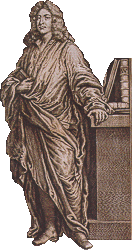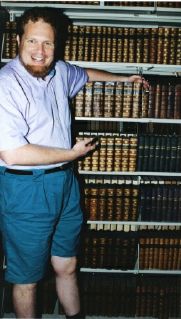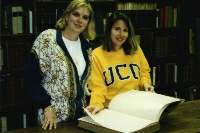 With the advent of the millennium, even the most
jaded scholars will realize that an age of wonders is once
again beginning. True, a few scowling cynics have
alleged that every library has already been explored,
maybe even trammelled into the ground by the worn
Wallabies of wardrobe-penurious
professors. Some melancholy savants have even doubted
John Dryden's famous verdict (and the motto of The
Explicator) by worrying that "the last line" has indeed
been explicated--that the last unautopsied book has
already been checked out for the last time from the last
rusting stack by the last original thinker.
With the advent of the millennium, even the most
jaded scholars will realize that an age of wonders is once
again beginning. True, a few scowling cynics have
alleged that every library has already been explored,
maybe even trammelled into the ground by the worn
Wallabies of wardrobe-penurious
professors. Some melancholy savants have even doubted
John Dryden's famous verdict (and the motto of The
Explicator) by worrying that "the last line" has indeed
been explicated--that the last unautopsied book has
already been checked out for the last time from the last
rusting stack by the last original thinker.
Well, by Zeus, these skeptics have erred (what else is it that skeptics do?)! No less prestigious a region than the Wild West--or, apropos of our era of mass marginalization, the boundary of the wild west--has rustled up one of history's most astonishing libraries. This new facility promises to serve as both a major resource for Enlightenment studies and as a monument to the history of neo-Augustan connoisseurship, amalgamationism, and collectorial ideology.
This new lone star on the western archival horizon goes by the name of The Noel Collection of The Noel Memorial Library of Louisiana State University at Shreveport (not Baton Rouge). Shreveport, the underapplauded home town of O. J. Simpson attorney Johnnie Cochran, is a surprisingly accessible settlement, an Ark-La-Tex border town located a short day's stampede from such saddles of learning as Dallas, Houston, Baton Rouge, Memphis, Knoxville, Lawrence, Fayetteville, St. Louis, Lexington, and even Chicago. Only two hours direct flight time from two-thirds of America's population, the Noel Library is surely one of our most reachable research resources. Private pilots will get a warm reception at the Shreveport general aviation terminal and will especially enjoy sinking into Shreveport's unmissable 10,000 foot, B-52-capable runway.
Superintended by Professor Robert Leitz, an eminent scholar of Charles Chesnutt and Jack London, the Noel Collection sprawls through the upper floor of the Noel Memorial Library, a stunning tribute to postmodern, eclectic library design. No expense has been spared. On the outside entablature, the solitary word "Noel" glows religiously (if also a little secularly) before the warm southern sun. Inside, nature opens to vision. Featuring the finest climate control available--subtle fanjets quietly spin away any incorrigible pockets of moist air--this Utopia for paper abides in high-tech perpetual primavera. Springtime in the Rockies has been superseded by springtime for the bookies. Unlike many overused reading rooms, where surly guardians try to harness reader-invaders into hard stools, the Noel offers its clients exceptional working conditions. With due permission, users may browse the shelves and even the vault. Indeed, this collection is a browser's resource. Perambulation is presently its primary cataloguing technology.
To understand and use the Noel Collection, one must bear in mind its history as well as its status as a postmodern monument to early-modern connoisseurship. The founder of the collection, James "Sunny" Noel, has self-fashioned a life reiterating that of the best Augustan projector-bibliophiles. Making his fortune in speculative investment and capital re-allocation, he devoted his formidable resources to building a self-consciously great library. Like one of Henry Fielding's squirearchs, Noel planted his library not in some clattering urban center, but in his serene country seat. Students of Augustan connoisseurship have doubtless noted the interaction, in eighteenth-century collections, between the gusto for general comprehensiveness and the idiosyncratic methods used to achieve this end. Germany's Corvey library, for example, tries to represent the whole spirit of Enlightenment by amalgamating English romances--important works of prose fiction, to be sure, but hardly the whole Aufklrung. In the case of the Noel Library, the idee fixe is that of the "first edition" or "collectible" book, free of any constraining regard for themes or topic areas or national cultures. Like John Soane's museum in London but on a grander scale, the Noel Collection is the purest expression of unmitigated enthusiasm for whatever might be or become collectible. Its massive holdings sum up to an awesome temple in the cult of the "rare book."
For bibliophiles and dix-huitimistes, the results are nothing short of fantastic, gothic, and sublime. Living as we do in an age of non-linear knowledge, an era where quantum distributions of scattered phenomena produce islands of form and inlets of order, we are fully able to appreciate the finials of wit jutting from this cathedral of chaos. Acquiring tens of thousands of volumes, often whole collections, by crate, carload, and chance, the wildly amalgamative Noel seized books with Ossianic abandon. Louisiana's answer to John Ruskin, Noel steadfastly refused to stuff his booty into conventional, post-gothic, pedestrian arrangements. Many of his accumulating books even passed through several years of purgatory in a steamy, otherwise abandoned railroad warehouse.
 Browsers of the Noel Collection are presented
with
endless surprises. One night early in April 1995, this
author accompanied Librarian Leitz to the collection.
The goal: sniffing out especially rare books for
relocation into the security vault. In only 30 minutes we
had pulled two full trolleys of exquisite rarities. We
quickly deduced that no vault could hold all the
important early volumes to be found. During this
excursion, we encountered countless amazing
juxtapositions. On one shelf, a seventeenth-century
edition of Sandys's travels rested between the first
paperback edition of Desi Arnaz's autobiography and an
anthology of aphorisms gleaned from talkshow host Phil
Donohue. In another purlieu, full runs of major
eighteenth-century literary periodicals (a strength of the
collection) ran off into first-edition series of the
Shreveport Rose Club Bulletin. It was not unusual to
find a first- (and only-) edition corpus of political
prophecies by FBI-honcho J. Edgar Hoover nestling
alongside an early edition of Lord Byron's juiciest lyrics.
Comical as they are, these endless juxtapositions make a
point about our post-Augustan tendency to body-slam
knowledge into standardized categories.
Browsers of the Noel Collection are presented
with
endless surprises. One night early in April 1995, this
author accompanied Librarian Leitz to the collection.
The goal: sniffing out especially rare books for
relocation into the security vault. In only 30 minutes we
had pulled two full trolleys of exquisite rarities. We
quickly deduced that no vault could hold all the
important early volumes to be found. During this
excursion, we encountered countless amazing
juxtapositions. On one shelf, a seventeenth-century
edition of Sandys's travels rested between the first
paperback edition of Desi Arnaz's autobiography and an
anthology of aphorisms gleaned from talkshow host Phil
Donohue. In another purlieu, full runs of major
eighteenth-century literary periodicals (a strength of the
collection) ran off into first-edition series of the
Shreveport Rose Club Bulletin. It was not unusual to
find a first- (and only-) edition corpus of political
prophecies by FBI-honcho J. Edgar Hoover nestling
alongside an early edition of Lord Byron's juiciest lyrics.
Comical as they are, these endless juxtapositions make a
point about our post-Augustan tendency to body-slam
knowledge into standardized categories.
The user of the Noel Collection may be shocked to find more than a few traces of Noel's unique approach to library conservation, including his rebinding of many early books in neon-colored or contact-paper- enriched boards. In the spirit of Ted Turner, some eighteenth-century graphics have been colorized with pastel pencil. Yet Noel's approach is not only true-blue Augustan--rebinding of books in anachronistic covers or revising them in startling ways was common practice in the good old days--but it is also likely to become an item of historical interest in its own right. There are plenty of copies of Hogarth around, but Noel's is one of the few that could become a collectible for reasons beyond its provenance. Noel's curatorial works could well end up in a British Museum show on varieties of connoisseurship. An exhibition on modes of collection and conservation might be a good way to inaugurate the Noel Collection as a research facility. Despite having been assembled by the "ultimate amateur," the Noel library is an expert's tool. It richly rewards those with patience, experience, intuition, a keen eye, and scholarly savoir-faire, but it daunts anyone who depends on catalogues, finding aids, or library assistants (there are none). Charting such a labyrinth is a little like trying to number all the myriad bubbles in Lawrence Welk's champagne, but a preliminary if anecdotal report of major assets may go some way in sizing up the 50,000 or so out of a total of 250,000 volumes that could prove useful to seventeenth- and eighteenth-century scholars.
Noel's zeal for early editions made him a frequent buyer of such seemingly undistinguished books as translations and standard classical texts. However inadvertently, the Noel Collection has thus emerged as a resource in the underevaluated but potentially fertile area of the history of translation. It reminds us that literary originality is a new idea. Holdings include a 1558 Virgil, a 1595 Horace, a 1670 Macrobius, a 1683 Lucretius (with a remarkable emblematic frontispiece depicting the Light of Nature), Sarah Fielding's Xenophon, Bentley's Horace, and many other ancients as "Englished" by early philologists. Eighteenth-century interpretations of British antiquity appear in numerous works on Scottish history, including William Guthrie's Scotland and Grammar and Present State of the Several Kingdoms of the World. Rhetoricians will have a field day with the huge supply of eighteenth-century treatises on the oral and written arts.
Those interested in Augustan redactions of Biblical history or in speculative theology will find much to choose from, whether early editions of Wesley's works (including his Life of Jesus Christ), popular tracts such as The Life of St. Ignatius and The Condemnation of Valentine the Tritheist, Taylor's Concordance, Watson's Apology for Christianity, assorted Papal Bulls, Du Bartas's Weekes and Workes, or Lowth's visionary evocations of Isaiah. Those relishing the unsavory side of theology can have a look at the hilariously illustrated Memorials of Superstition, an eroticized diatribe against monkish self-flagellation (be sure and catch the Catamite and the Cartesian on the same index page). Those with more refined tastes can dip into countless books on the occult, including the Bibliotheque des Philosophes Chimiques, while those who prefer their deviance straight, without any theological chasers, can savor the sheets of Terrae-Filius: Or, The Secret History of the University of Oxford.
The lighter, daintier, belle-lettristic side of the era also circulates in the Noelian whirlwind. Port-and-leather, cigar-chomping Johnsonians will be able to bite into huge servings of the Great Cham, including several editions of the Dictionary and side dishes of Thraliana and Boswellian. Shakespeare's Seven Ages illuminates the history of Shakespearian production and interpretation, as does another non-eighteenth- century treasure, the notebook of silent film star Rudolf Valentino's wife, a Hollywood costume designer. Critical theory gets its due in the form of Spence's Essay on Mr. Pope's Odyssey (and many other tomes). A full cadre of pre-novel and novel-related works have enlisted in the Noel Collection, for example the delightful Countess D'Anois's Novels and Tales of the Fairies and a shelf full of retellings of the Arabian Nights. Surely one of the most important items is the extremely rare first edition of Smollett's Peregrine Pickle, accompanied by other valuable Smollettiana. Those exploring the interaction of the visual with the textual will not be disappointed by the Noel Library's vast resources in the area of William Hogarth and other graphic artists.
 Stubbornly, even madly
interdisciplinary, the Noel
Collection has much to offer for investigators taking
anthropological or "cultural studies" approaches. Travel
books abound, whether the aforementioned Sandys'
Travailes, Captain Cook's Last Voyage, or any of a dozen
imaginative geographers. The curious Rom Antiqu
(1678) includes a kind of physiognomical tour through
the heads of the ancient Romans. Diaries like the
Memoires de M. Joly tell us much about the insider's
view of the period, while the Collection of eighteenth-century
encyclopedias tell us how the period saw
everything around it. True to his character as a country
gentleman, Noel has provided a large number of
domestic manuals, courtesy books, books on the duties
of women, gardening encyclopedias, and, perhaps as an
homage to the gambling state of Louisiana, texts on
eighteenth-century games.
Stubbornly, even madly
interdisciplinary, the Noel
Collection has much to offer for investigators taking
anthropological or "cultural studies" approaches. Travel
books abound, whether the aforementioned Sandys'
Travailes, Captain Cook's Last Voyage, or any of a dozen
imaginative geographers. The curious Rom Antiqu
(1678) includes a kind of physiognomical tour through
the heads of the ancient Romans. Diaries like the
Memoires de M. Joly tell us much about the insider's
view of the period, while the Collection of eighteenth-century
encyclopedias tell us how the period saw
everything around it. True to his character as a country
gentleman, Noel has provided a large number of
domestic manuals, courtesy books, books on the duties
of women, gardening encyclopedias, and, perhaps as an
homage to the gambling state of Louisiana, texts on
eighteenth-century games.
Beyond these exemplary treasures, the Noel Collection includes many documents that, as a result of eons of heaping, shuffling, amalgamation, and dissipation, have miraculously come together in theme groups, groups that tacitly suggest possibilities for research in and beyond the eighteenth century. A huge bundle of funeral orations on George Washington could easily generate articles, maybe even tenure, for some necropolite colleague. What might be tastefully called a book cluster on "speculative biology" will draw the attention of those interested in the history of science, eugenics, Utopianism, and racism. Noel's eclecticism announces itself through a veritable cauldron of books on the occult and its theatrical representations. His ability to merge the close encounter with the long view of library acquisitions may account for the generous representation of philosopher George Berkeley's late, hermetical speculations.
Perhaps the most remarkable feature of the indectically-challenged Noel Collection is that, qua monument, it is the taxonomy-immune eighteenth century. It refuses to be any one thing or situate itself in any one time or stick to any one theme. Rather, it implements the spirit of eclecticism evidenced by the Aubreys, the Rays, the Behns, the Lockes, the Malletts, the Fieldings, the Equianos, and the Goldsmiths. An example of what the Augustans would have called "imitation," living as an ancient might have lived had he lived in a later era, the Noel Collection refuses to seal the eighteenth century into a time capsule. It affirms the integrity, continuity, and variety of the collectorial idiom from the Restoration onward to today; it reads that idiom into earlier history, from the Interregnum backward. Its users will thus have more of a "various" Augustan experience than any reader in the BL North Reading Room. More of a living organism loosely tied to a mind than a dead weight attached to a catalogue, the Noel Collection reminds us that, just maybe, the Conga-thumping Desi Arnaz might have more in common with the exploratory Sandys than we have yet recognized.
TO VISIT THE NOEL LIBRARY: Contact the curator,
Professor Robert Leitz, in care of the Noel Memorial
Library, Louisiana State University at Shreveport,
Shreveport, Louisiana, 71115-2399; telephone (318)
797-5069; FAX (318) 797-5156; e-mail
rleitz@pilot.lsus.edu. Owing to the
obliging informality of the collection as well as to the
challenge of finding suitable accommodation in
Shreveport, an advance conversation and an
appointment are highly recommended. You can catch
Professor Leitz at the upcoming SCSECS meeting; browse
our list of proposed panels to
see the seminars he'll be holding on use of the Collection
at that time.
The Wallaby: an inexpensive and
inelegant shoe often affected as a secretly pretentious
insignia of contemptus mundi by journeyman-academics
who wish to seem serious and committed.
My appreciations to Paul Johnston
of the State University of New York at Plattsburgh for
drawing my attention to the importance of the Noel Library
itself as a collectible artifact.
Webmaster's Note: I have examined this same copy of
the book, and would like to add another item of interest to scholars of the later
eighteenth and early nineteenth centuries. According to a spidery signature on
the flyleaf, dated "1832," this particular Life of Christ once belonged to
that celebrated Poet Laureate and bane of Romanticism, Robert Southey. --S.S.

Back to the essay
Back to the essay
Back to the essay
 The guidelines:
The guidelines: